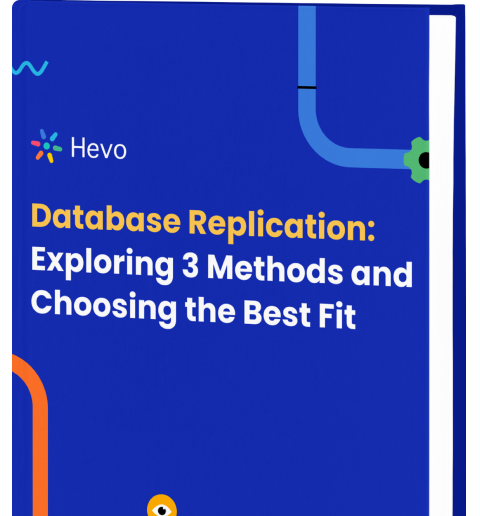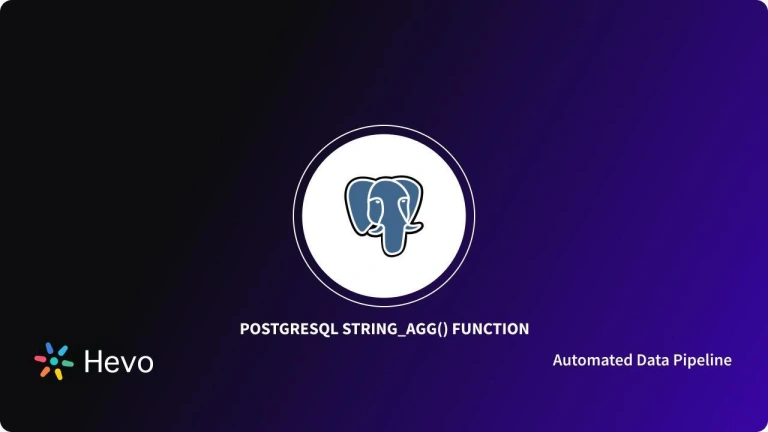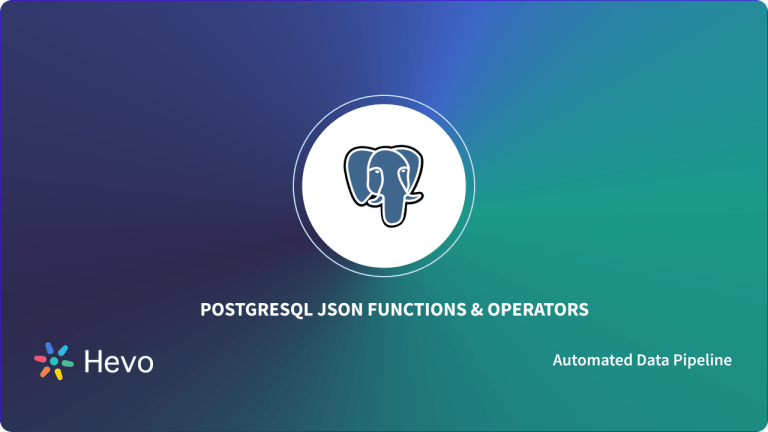PostgreSQL offers a variety of data types for columns. PostgreSQL users have many options, from in-built data types to user-defined ones. If you have acquainted with PostgreSQL in your application development, then you must be familiar with the Array data type for columns in PostgreSQL.
Creating, querying, and performing operations on array columns are some of the primary functions in PostgreSQL. But there would be some scenarios where you need to convert arrays back to rows in PostgreSQL.
For example, let’s say you want to aggregate two array columns into one set. But, PostgreSQL only offers the UNION method for rows, not for array columns. Enter, PostgreSQL unnest() Function — to the rescue!
With PostgreSQL unnest() function, you can convert arrays to rows.
You crashed on the correct link if you are searching for a step-by-step tutorial on unnest() Function in PostgreSQL. In this article, you will gain information about PostgreSQL unnest() function. You will also gain a holistic understanding of different operations associated with the PostgreSQL unnest() function, its syntax, and example use cases.
Table of Contents
Prerequisites
- Basic knowledge of writing PostgreSQL Queries
- pgAdmin dashboard
What is unnest() Function in PostgreSQL?
PostgreSQL unnest comes under the umbrella of array functions. The purpose of unnest function in PostgreSQL is to expand the array into rows. Unnest function generates a table structure of an array in PostgreSQL.
Unnest array function is beneficial in PostgreSQL for expanding the array into the set of values or converting the array into the structure of the rows. PostgreSQL offers unnest() function. It is a system function that allows you to extend an array to a specified number of rows.
When converting an array into a table structure on an older version of PostgreSQL, we had to utilize an array with a cross join. After merging it, we produced a series of the array using a cross join. After creating a series, the array’s items will be arranged into a table using the cross join and produce series functions. It was an overwhelming process of covering arrays to rows in older versions of PostgreSQL.
Ditch the manual process of writing long commands to connect your PostgreSQL and choose Hevo’s no-code platform to streamline your data migration.
With Hevo:
- Easily migrate different data types like CSV, JSON etc.
- 150+ connectors like PostgreSQL and Google Sheets(including 60+ free sources).
- Eliminate the need of manual schema mapping with the auto-mapping feature.
Experience Hevo and see why 2000+ data professionals including customers, such as Thoughtspot, Postman, and many more, have rated us 4.3/5 on G2.
Get Started with Hevo for FreeWhy Use unnest() Function in PostgreSQL?
In the above section, we have seen how long it takes to convert the array into row structures in the older version of PostgreSQL. Therefore, the PostgreSQL unnest function comes with the following advantages:
- By utilizing the unnest function, we can avoid the cross join or create series functions to turn an array into a table-like structure. We’ve just used the unnest method with an array.
- In PostgreSQL, we utilized an array for numbers or text to turn the array into a table-like structure.
- We can also use the unnest function with an order by clause. We’re utilizing an order by clause with 1 and an unnest function.
- We can also utilize the limit clause with the unnest function. When we use a limit clause, it returns the result based on the number we specified with the limit.
PostgreSQL unnest() Function Overview
PostgreSQL unnest() function is essential in data manipulation. In this section, we will go through some fundamental unnest operations, their functionality, and examples. These operations will aid us in dealing with PostgreSQL Unnest functions efficiently. Let’s address them one by one. But, before we get to the functions, let’s look at PostgreSQL’s unnest basic function syntax.
Syntax of unnest() Function
The syntax of the PostgreSQL Unnest function is as follows:
unnest(array)- unnest() is PostgreSQL function to to set the elements in table-like structure.
- Unnsest function must be provided with an array as an argument.
The unnest() method in PostgreSQL returns a set, with each member in the array becoming a row in the set.
Unnest One-Dimension Array in PostgreSQL
The below example demonstrates how to use PostgreSQL’s unnest() function to convert a one-dimensional array into a set.
Example 1: Unnest method using array as a number. The below code snippet will expand the number array of size 7 into 7 rows.
SELECT unnest(ARRAY[10, 11, 12, 13, 14, 15, 16]);- The
SELECTstatement retrieves data from a database. unnest(ARRAY[10, 11, 12, 13, 14, 15, 16])is a function that takes an array of numbers as input.- This function breaks down the array into individual rows.
- The output will display each number from the array on a separate line.
- This query is useful for transforming arrays into a more manageable row format for further analysis.
Output:
Example 2: Unnest method using array as text. The below code snippet will expand the text array of size 6 into 6 rows.
SELECT unnest(ARRAY['Sunday', 'Monday', 'Tuesday', 'Wednesday', 'Thursday', 'Friday']);Output:
Unnest Multi-Dimension Array in PostgreSQL
This section illustrates how to use PostgreSQL’s unnest() function to convert a two-dimensional array into a set.
Example: Unnest method using 2-D array as an integer. The below code snippet will expand the integer array into 6 rows.
SELECT unnest('[2:4][2:3]={{21,22},{23,24},{25,26}}'::integer[]);- The
SELECTstatement is used to query data from a database. - The
unnestfunction takes a multidimensional array of integers as input. - The input array
'{ {21, 22}, {23, 24}, {25, 26} }'::integer[]represents a 2D array with three sub-arrays, each containing two integer values. - This function breaks down the 2D array into individual rows.
- The output will list each integer from the sub-arrays in separate rows, making it easier to work with or analyze the data.
Output: In the result set, each array element becomes a row.
Expand Multiple Array with Unnest Function
The PostgreSQL unnest() function allows you to expand one array at a time and also expand many arrays (of potentially different data types) into a set of rows.
Syntax:
unnest ( anyarray, anyarray [, ... ] ) Note: If the arrays are not of the same length, NULLs are used to pad the shorter ones. This form is only permitted in the FROM clause of a query.
Example 1:
SELECT * FROM
unnest(
ARRAY[1, 2, 3, 4],
ARRAY['Shawn', 'Bible', 'Build', 'Jeff'],
ARRAY[23, 24, 28, 27]
) AS data(id,name,age);- The
SELECTstatement retrieves all columns from the result of theunnestfunction. - The
unnestfunction takes multiple arrays as input, creating a combined set of rows. - In this case, three arrays are provided: one for IDs (
ARRAY[1, 2, 3, 4]), one for names (ARRAY['Shawn', 'Bible', 'Build', 'Jeff']), and one for ages (ARRAY[23, 24, 28, 27]). - The
AS data(id,name,age)clause defines the names of the columns in the resulting output, labeling them asid,name, andage. - The output will display a table where each row corresponds to an entry from the three input arrays, aligning IDs with names and ages.
Output:
In this case, the unnest() method extends several arrays, similar to extending each array individually into a set, and then connects multiple sets by row.
Unnest Function with Order By Clause
The unnest PostgreSQL function can also be used with an order by clause. We are using an unnest function with an order by clause.
Example: The example below illustrates an unnest function with a limit clause. In the following example, we utilize a number array.
Note: We have used the ordinal value of the column with the Order By clause. In the example below, ‘2’ is the ordinal value of the second column hence the results will be ordered according to the 2nd column.
SELECT * from unnest(
ARRAY[1, 2, 3, 4, 5],
ARRAY['Arya Stark','Snow Stark','Sensa Stark'])
As data(id, name) order by 2;
- The
SELECT *statement retrieves all columns from the result of theunnestfunction. - The
unnestfunction is used here to combine two arrays: an array of integers (ARRAY[1, 2, 3, 4, 5]) and an array of strings (ARRAY['Arya Stark', 'Snow Stark', 'Sensa Stark']). - Each integer in the first array is paired with an element from the second array, creating rows of data.
- The
AS data(id, name)clause defines the resulting column names asidandname. - The
ORDER BY 2clause sorts the output by thenamecolumn in ascending order, which organizes the names alphabetically.
Output:
unnest() Function With Limit Clause
In PostgreSQL, we have also used the limit clause with the unnest function. When utilizing the limit clause, the resultant row set will be displayed based on the limit we set using the unnest function.
Example: The example below illustrates an unnest function with a limit clause. In the following example, we utilize a number array.
SELECT unnest(ARRAY[1.43, 12.4, 43.4, 1.43, 5.45, 6.66, 6, 7, 8, 9, 10]) limit 5;Output:
unnest() Function With Distinct Clause
DISTINCT can aid you in removing duplicates from any type of data. It does, however, need the usage of rows as data. This signifies that this function supports integers, text, floats, and other data kinds, but not arrays. You must first use the UNNEST function to eliminate duplicates to transform your array-type data into rows. The transformed data rows will then be given to the DISTINCT clause. The output shows that the array was transformed into rows, and then only the distinct values from these rows were obtained using the DISTINCT clause.
Example: First, the text array has been converted into rows using the UNNEST function. These rows will be sorted into ascending order using the ORDER BY clause, as shown below code snippet.
SELECT DISTINCT UNNEST( '{Pol, Arm, Kinn, Pol, Porchay}'::text[] )
As result Order BY 1;Output:
You can also take a look at how you can work with PostgreSQL JSON Functions and Array Functions to get a better understanding of PostgreSQL Functions.
Benefits & Use Cases of Postgres unnest() Function
Benefits:
- Simplifies Array Handling: Makes it easier to work with arrays by expanding them into individual rows for better readability and processing.
- Improves Query Efficiency: Enables efficient transformations and joins by converting arrays into rows for operations like filtering, aggregating, or joining with other tables.
- Flexible Data Analysis: Supports dynamic analysis by converting array-based data into a tabular format for complex queries.
- Streamlines Joins: Helps in joining array elements with other tables without needing additional logic or loops.
- Reduces Complexity: Eliminates the need for custom scripts or manual transformations when working with array-based data structures.
Use Cases:
- Handling Nested Data: Extracting individual elements from arrays stored in database columns, such as tags or lists.
- Data Transformation: Converting arrays into rows to perform operations like filtering, sorting, and grouping.
- Joining Arrays with Tables: Matching array elements with other table records, such as finding all users with specific roles stored in an array.
- Aggregations: Calculating metrics like counts or averages from array elements after expanding them into rows.
- Simplifying JSON Data: Flattening arrays in JSON fields when working with semi-structured data.
By leveraging the UNNEST PostgreSQL function, you can handle array data in PostgreSQL with greater ease and flexibility, enabling more powerful data processing and analysis.
Conclusion
The blog offered an overview of the PostgreSQL unnest(), a definition of the Unnest’s function, and examples. The lesson then demonstrated how to use unnest() function with Distinct, Limit, and Order by clause in PostgreSQL.
Hopefully, you will try leveraging the PostgreSQL unnest() function for your future projects. Feel free to leave a comment below expressing your thoughts or recommendations.
If you are a PostgreSQL user, replicating data into a warehouse using ETL for Data Analysis can get demanding. This problem is exaggerated because they need extensive money and resources to hire data engineers and analysts to make sense of this data.
Luckily, you can set up and start Data Replication from PostgreSQL to your favorite warehouse in a matter of minutes using Hevo.
Sign up for a 14-day free trial and simplify your data integration process. Check out the pricing details to understand which plan fulfills all your business needs.
Frequently Asked Questions
1. What is unnest in PostgreSQL?
The UNNEST function in PostgreSQL is used to expand an array into a set of rows. It takes an array and returns a set of rows, each containing one element of the array.
2. How to unnest text in PostgreSQL?
If you have text data that is delimited by a specific character (e.g., commas or spaces) and you want to split this text into separate rows, you can combine UNNEST with STRING_TO_ARRAY.
3. What is the opposite of Unnest in PostgreSQL?
The opposite of UNNEST would be to aggregate rows into a single array. In PostgreSQL, you can use the ARRAY_AGG function to aggregate rows into an array.











